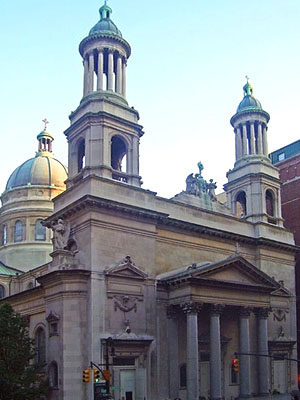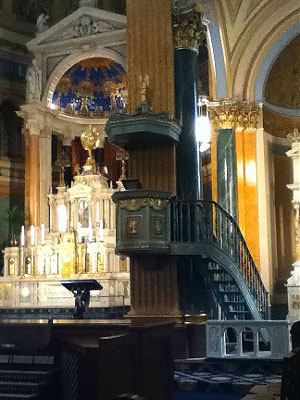| |
 |
 |
 |
| Comment on this report, or find other reports. |
 |
| Our Mystery Worshippers are volunteers who warm church pews for us around the world. If you'd like to become a Mystery Worshipper, start here. |
 |
| Find out how to reproduce this report in your church magazine or website. |
|
|
| 2510: St Jean
Baptiste, New York City |
 |

Photo:
Daniel Case
|
 |
Mystery
Worshipper: Acton Bell.
The church:
St Jean
Baptiste, New York City.
Denomination:
Roman Catholic,
Archdiocese
of New York. The parish is administered by priests of the
Congregation
of the Blessed Sacrament, more commonly called Blessed Sacrament
Fathers.
The building:
In 1900, the robber baron tobacco and transportation magnate
John Fortune Ryan, who lived nearby, financed the building of
this structure to replace an earlier one on the same site. It
combines elements of the Italian Renaissance Revival and Baroque,
and features two cupola-topped towers that flank an enormous
dome. The interior is barrel vaulted with Gustavino structural
tiles that, unusually, feature a Florentine-style decorative
high relief pattern. All of the column capitals are gilded and
there are several dozen stained glass windows, including a row
that encircles the entire dome. The high altar is topped by
a half dome mosaic and features a six-foot high representation
of a monstrance. The pews, confessionals and choir stalls are
elaborately carved and feature clusters of grapes as a design
motif. On the south wall there is also the national shrine to
St Anne, about which more below.
The church:
The parish was originally established to serve the French Canadian
immigrant population and remained their national parish until
well into the 20th century. The exposition and adoration of
the Blessed Sacrament is central to the rule of the Blessed
Sacrament Fathers. There are prayer groups devoted to this mission
that involve both clergy and the laity. As a church community
they offer programs for the homeless and the hungry as well
as the addicted. There is also a variety of social groups that
are detailed on their website. The shrine to St Anne was established
quite by accident. In 1892 a French-Canadian priest traveling
through New York stopped overnight at the rectory. When the
pastor learned that he was carrying a relic of St Anne with
him, he asked the visitor if he would extend his stay for a
few weeks so that the relic might be exposed for veneration.
He did, and it was, and crowds gathered as the news spread.
A man afflicted with epilepsy touched the relic and never again
experienced a seizure. The visiting priest eventually went on
his way, but sent back a fragment of the relic for permanent
display. Soon thereafter he arranged for a new relic from the
shrine of St Anne in France to be sent to the church. In 1970
an elderly woman was murdered by intruders as she knelt before
the relic, thus causing the shrine's deconsecration. The present
shrine was set up and consecrated shortly thereafter.
The neighborhood:
This is the Upper East Side of Manhattan, an area that stretches
east of Fifth Avenue from 59th Street on the south to 96th Street
on the north. The church is smack in the middle of the so-called
silk stocking district, which boasts some of the priciest property
in the USA and, given the population density and high per capita
income, is touted as home to the country's greatest concentration
of wealth. Famously safe, charmingly green, the area tends to
be the sleepiest neighborhood in "the city that never sleeps."
Historically, the East Side of Manhattan has been notoriously
under-served by the city's subway system, and a new line is
currently being dug along Second Avenue to Grand Central Station.
The construction has been a major inconvenience to many, but
it could be worse – at least they aren't using dynamite
to blast tunnels out of the bedrock as they did for earlier
subway tunnels, often with deadly results.
The cast:
I don't know. The officiant was an elderly priest. His name
wasn't mentioned anywhere, and I didn't see a picture on their
website to match with a name. He was assisted by two acolytes,
one of whom did double duty as the thurifer, and a lay reader.
The date & time:
Fourth Sunday in Lent, March 10, 2013, 12.00pm.
What was the name of the service?
Celebrating the Liturgy.
How full was the building?
I counted precisely 105. The building could have held many,
many more.
Did anyone welcome you personally?
No. I arrived shortly after the previous mass had ended, and
the only people there were several obviously homeless souls
with all of their worldly goods arranged around them.
Was your pew comfortable?
Unremarkable. It was the standard issue pew: hard back and seat,
unrelieved by a cushion.
How would you describe the pre-service
atmosphere?
Very quiet. One of the homeless ladies was praying before the
shrine to St Anne, and there were several others sitting with
their eyes closed. More people arrived closer to the published
start time, but it remained hushed.
What were the exact opening words of the
service?
"In the name of the Father, and of the Son, and of the Holy
Spirit."
What books did the congregation use during the
service?
A hard bound Gather Comprehensive hymnal was in the
pews but remained unopened. A very well-done service leaflet
with the mass order, music and announcements was available at
the entrance.
What musical instruments were played?
Organ, choir, and cantor to lead songs (whose efforts were fruitless,
as nobody in the congregation sang).
Did anything distract you?
The interior is just a riot of ornament and color: pale blue
and green, ochre, ombre, yellow, gold, red, just to name a few,
with colors I wouldn't ordinarily think of putting next to one
another all jumbled together. It is all so over-the-top that
it kind of works. I also found myself lost in the Gustavino
vaulting and the ceiling frescoes of various types of clouds.
I thought it very unusual to have both stormy and calm varieties
depicted.

Was the worship stiff-upper-lip, happy clappy, or
what?
Restrained novus ordo with a twist at the end, I'd
say. There was a nod to tradition with incense, the sanctus
bell, and eucharistic prayers that were chanted. The priest
also wore a very traditional vestment of rose and purple damask
that was quite pretty. The memorial acclamation, great amen
and sanctus were set to something modern and bland, and nobody
but the choir sang them. None of the congregation sang any of
the hymns either, not even that most hummable tune, "Amazing
Grace", which was sung at the offertory. (Go figure!) The
post communion hymn was supposed to be a meditation to ask for
the guidance of the Holy Spirit during the period of discernment
for the election of the Pope. What was chosen was some Taizé
community toe-tapper, at which I could barely restrain my eyes
from rolling back into my head. The concluding rite, however,
was as moving at the Taizé-thing was groan-inducing.
At the end of the service, an enormous monstrance was brought
out for the exposition of the Blessed Sacrament and Adoramus
Te was sung by all, kneeling. It was very solemn. And I
did note that people didn't rush out after receiving communion,
but stayed through to the very end.
Exactly how long was the sermon?
5 minutes.
On a scale of 1-10, how good was the preacher?
7 – While the preacher was obviously skillful, he did leave
me wishing for more. It is very hard to say or do much in five
minutes.
In a nutshell, what was the sermon
about?
He attempted to unpack the reading of the day, the parable of
the prodigal son. He asserted that we live with such a culture
of revenge today that the idea of a prodigal returning seems
a remote one. The parable asks for a type of forgiveness that
mirrors divine forgiveness. Few exhibit this, but it is possible.
John Paul II, for example, was able to forgive his would-be
assassin and pray for his conversion.
Which part of the service was like being in
heaven?
I suppose it was how contemplative this mass was, which is something
I don't really associate with the novus ordo at all.
And which part was like being in... er... the other place?
The cantor was in obvious vocal distress, largely flat throughout,
but the responsorial psalm was a real trial for her (and us
too).
What happened when you hung around after the service looking lost?
Nothing quite so Protestant as a coffee hour on offer. The priest
did make an effort to wish us a good day on our way out.
How would you describe the after-service
coffee?
We managed to get a table at a nearby bistro.
How would you feel about making this church your regular (where 10 = ecstatic, 0 = terminal)?
6 – Not really my 'hood, and a bit far to travel.
Did the service make you feel glad to be a
Christian?
Of course.
What one thing will you remember about all this in seven days' time?
Homeless in the pews, and how the church remembered these forgotten
people. I hadn't expected an Upper East side church to be so
kind to the homeless, by providing a safe and warm place to
sit unmolested during the day. |
|
|
 |
 |
 |
| We rely on voluntary donations to stay online. If you're a regular visitor to Ship of Fools, please consider supporting us. |
 |
 |
 |
| The Mystery Pilgrim |
 |
| One of our most seasoned reporters makes the Camino pilgrimage to Santiago de Compostela in Spain. Read here. |
 |
 |
 |
| London churches |
 |
| Read reports from 70 London churches, visited by a small army of Mystery Worshippers on one single Sunday. Read here. |
| |
|
|
|
|


